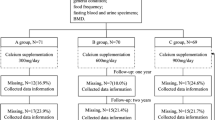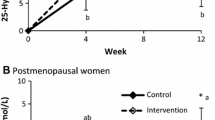Abstract
Dietary studies often report low calcium intake amongst post-menopausal Malaysian women and calcium deficiency has been implicated as part of the etiology of age-related bone loss leading to osteoporosis. Therefore, the objective of this study was to examine the effectiveness of high calcium skimmed milk (Anlene Gold™, New Zealand Milk, Wellington, New Zealand) to reduce bone loss in Chinese postmenopausal women. Two hundred subjects aged 55–65 years and who were more than 5 years postmenopausal were randomized to a milk group and control group. The milk group consumed 50 g of high calcium skimmed milk powder daily, which contained 1200 mg calcium (taken as two glasses of milk a day). The control group continued with their usual diet. Using repeated measures ANCOVA, the milk supplement was found to significantly reduce the percentage of bone loss at the total body compared to the control group at 24 months (control −1.04%, milk −0.13%; P<0.001). At the lumbar spine, the percentage of bone loss in the control group was significantly higher (−0.90%) when compared to the milk (−0.13%) supplemented group at 24 months (P<0.05). Similarly, milk supplementation reduced the percentage of bone loss at the femoral neck (control −1.21%, milk 0.51%) (P<0.01) and total hip (control −2.17%, milk −0.50%) (P<0.01). The supplemented group did not experience any significant weight gain over the 24 months. The serum 25-hydroxy vitamin D level improved significantly (P<0.01) from 69.1±16.1 nmol/l at baseline to 86.4±22.0 nmol/l at 24 months in the milk group. In conclusion, ingestion of high calcium skimmed milk was effective in reducing the rate of bone loss at clinically important lumbar spine and hip sites in postmenopausal Chinese women in Malaysia. Supplementing with milk had additional benefits of improving the serum 25-hydroxy vitamin D status of the subjects.


Similar content being viewed by others
References
Lau EMC, Cooper C (1996) The epidemiology of osteoporosis:the oriental perspective in a world context. Clin Orthop 323:65–74
Anon (2001) Malaysian clinical practice guidelines on management of osteoporosis. Malaysian Osteoporosis Society
Department of Statistics (2000) Yearbook of statistics Malaysia. National Printing Department, Kuala Lumpur
Tee ES (1999) Nutrition of Malaysians: where are we heading? Malay J Nutr 5:87–109
Lau EMC, Suriwongpaisal P, Lee JK et al. (2001) Risk factors for hip fracture in Asian men and women: the Asian Osteoporosis Study (AOS). J Bone Miner Res 16:572–580
Ismail MN (1992) Malnutrition and food consumption pattern in Malaysians. Int J Food Sci Nutr 43:69–78
Chee SS, Ismail MN, Ng KK, Zawiah H (1997) Food intake assesment of adults in rural and urban areas. Malay J Nutr 3:91–102
Dawson-Hughes B, Dallal GE, Krall EA et al. (1990) A controlled trial of the effect of calcium supplementation on bone density in postmenopausal women. N Engl J Med 323:878–883
Reid IR, Ames RW, Evans MC et al. (1995) Long-term effects of calcium supplementation on bone loss and fractures in postmenopausal women: a randomized controlled trial. Am J Med 98:331–335
Prince R, Devine A, Dick I et al. (1995) The effects of calcium supplementation (milk powder or tablets) and exercise on bone density in postmenopausal women. J Bone Miner Res 10:1068–1075
Lau EMC, Woo J, Lam V, Hong A (2001) Milk supplementation of the diet in postmenopausal Chinese women on a low calcium intake retards bone loss. J Bone Miner Res 16:1704–1709
National Coordinating Committee on Food and Nutrition (1997) Malaysian dietary guidelines. Ministry of Health, Malaysia
Tee ES, Ismail MN, Mohd Nasir A, Khatijah I (2000) Nutrient Composition of Malaysian foods. ASEAN Food Habit Project, National Subcommittee on Protein: Food Habits Research and Development, Malaysia
Baran D, Sorensen A, Grimes J et al. (1989) Dietary modification with dairy products for preventing vertebral bone loss in premenopausal women: a three-year prospective study. J Clin Endocrinol Metab 70:264–270
Storm D, Eslin R, Porter ES et al. (1998) Calcium supplementation prevents seasonal bone loss and changes in biochemical markers of bone turnover in elderly New England women: a randomized placebo-controlled trial. J Clin Endocrinol Metab 83:3817–3825
Riggs BL, O'Fallon WM, Muhs J et al. (1998) Long-term effects of calcium supplementation on serum parathyroid hormone level, bone turnover, and bone loss in elderly women. J Bone Miner Res 13:168–174
Peacock M, Liu G,Carey M et al. (2000) Effect of calcium or 25-OH vitamin D3 dietary supplementation at the hip in men and women over age of 60. J Clin Endocrinol Metab 85:3011–3019
Blumsohn A, Herrington K, Hannon AR et al. (1994) The effect of calcium supplementation on the circadian rhythm of bone resorption. J Clin Endocrinol Metab 79:730–735
Heaney RP, McCarron DA, Dawson-Hughes B et al. (1999) Dietary changes favorably affect bone remodeling in older adults. J Am Diet Assoc 99:1228–1233
Jensen C, Holloway L, Block G et al. (2002) Long-term effects of nutrient intervention on markers of bone remodeling and calciotropic hormones in late-postmenopausal women. Am J Clin Nutr 75:1114–1120
Acknowledgements
We are grateful to Professor Najib and Mr. Karuthan Chinna for assisting with the statistical analyses and Professor Ian Reid for his comments on the manuscript. The study was funded by New Zealand Milk.
Author information
Authors and Affiliations
Corresponding author
Rights and permissions
About this article
Cite this article
Chee, W.S.S., Suriah, A.R., Chan, S.P. et al. The effect of milk supplementation on bone mineral density in postmenopausal Chinese women in Malaysia. Osteoporos Int 14, 828–834 (2003). https://doi.org/10.1007/s00198-003-1448-6
Received:
Accepted:
Published:
Issue Date:
DOI: https://doi.org/10.1007/s00198-003-1448-6




